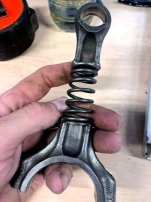Looking for someone out there that has experience with shortening and welding connecting rods. I understand this has been done for years, with varying success.
On this project I am installing a 28 chev crankshaft into a model T.
The modifications to the crankshaft front end and rear flange are completed. Next step is too make new main bearing caps to accomodate the larger journals on the chevy crank.
Before I grind the crank I need to decide whether to reduce the chevy rod throw journals down to accept the T connecting rods ( which will mean grinding from 1.5" down to 1.375" ).
Another option is to cut and shorten the chevy rod and attach the T rod upper end, therefore I can use the larger diameter (Chevy) big end while running the stock T pistons.
Dave
On this project I am installing a 28 chev crankshaft into a model T.
The modifications to the crankshaft front end and rear flange are completed. Next step is too make new main bearing caps to accomodate the larger journals on the chevy crank.
Before I grind the crank I need to decide whether to reduce the chevy rod throw journals down to accept the T connecting rods ( which will mean grinding from 1.5" down to 1.375" ).
Another option is to cut and shorten the chevy rod and attach the T rod upper end, therefore I can use the larger diameter (Chevy) big end while running the stock T pistons.
Dave



